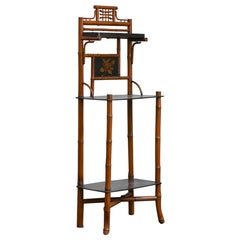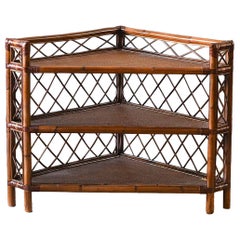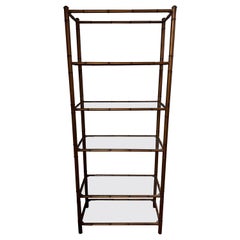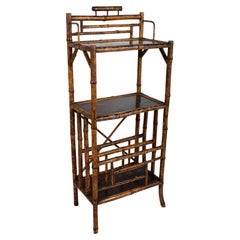Molto Collectibles Shelves
to
Height
to
Width
to
Depth
to
2
1
1
1
1
2
1
1
1
1
1
1
2
1
1
Japonisante Etagère in bamboo and lacquer attributed to Perret & Vibert, France
By Perret et Vibert
Located in Roma, RM
Japonisante Etagère in bamboo and lacquer attributed to Perret & Vibert, France late 19th century.
Product details
From the residence of Antonello Falqui – Falqui Collection.
Struc...
Category
Antique Late 19th Century Shelves
Materials
Bamboo, Wood
Bamboo and Wicker Étagère With Leather Bindings, Edizioni Molto
Located in Roma, RM
Bamboo And Wicker Étagère with leather bindings, Molto Editions
Dimensions : 70 L x 75 H x 70 D cm
Production: Molto Collectibles Editions.
Italian artisan manufacturing.
Category
2010s Italian Shelves
Materials
Leather, Bamboo, Wicker
Related Items
Faux Bamboo Etagere
Located in Redding, CT
Classic Faux bamboo Etagere with oil glaze drip. 6 shelf bookcase perfect for display and storage for your living room or bedroom. Glass shelves are re...
Category
Vintage 1980s Hollywood Regency Shelves
Materials
Metal
Antique 19th Century Anglo-Chinese Lacquered Bamboo Etagere Shelves, England
Located in London, GB
Antique 19th century Anglo-Chinese lacquered bamboo etagere shelves.
C.1880 England
In very good condition, with expected signs of wear commensurate with age.
Category
Antique 19th Century English Chinese Chippendale Shelves
Materials
Bamboo, Lacquer
$1,753
H 49.61 in W 21.66 in D 13.78 in
1970s Italian Bamboo & Wicker Etagere
Located in Aspen, CO
1970s Italian bamboo and wicker curved top etagere with four shelves. The Top shelf is perfect for showcasing a sculpture or objet while the bottom shelves fit vases, plates and more.
Category
Vintage 1970s European Shelves
Materials
Bamboo, Wicker
Antique Burnt Bamboo Etagere with Four Shelves
Located in West Palm Beach, FL
Antique bamboo etagere with four shelves. Very well made and sturdy. Nice detail on the sides and around the top. A great versatile piece.
Category
Antique 19th Century English Shelves
Materials
Bamboo, Oak
Antique Bamboo Etagere with Five Shelves
Located in West Palm Beach, FL
Antique burnt bamboo etagere / shelves. This piece has five shelves including the top one. Very nice and sturdy condition.
Category
Antique 19th Century English Shelves
Materials
Bamboo
Antique Tortoise Bamboo Etagere
Located in West Palm Beach, FL
Antique tortoise bamboo etagere / shelves to display your favorite pieces. Consisting of six separate shelves. Very versatile piece that will fit in a...
Category
Antique Late 19th Century English Shelves
Materials
Bamboo
Faux Bamboo Pagoda Etagere
Located in W Allenhurst, NJ
Pagoda form faux bamboo etagere in painted metal with four removable glass shelves.
Curbside to NYC/Philly $400
Category
Mid-20th Century Unknown Mid-Century Modern Shelves
Materials
Iron
Mid-Century Modern French Bamboo and Rattan Folding Étagère, 1960s
Located in Prato, IT
Mid-Century Modern French bamboo and rattan folding three shelves étagère.
This étagère is completely foldable as shown in the photos.
Beautiful patina due to age and use
Category
Vintage 1960s Italian Mid-Century Modern Shelves
Materials
Bamboo, Rattan
$1,508 Sale Price
20% Off
H 45.67 in W 23.63 in D 11.82 in
Bamboo Rattan Decorative Shelf Etagere
By Ficks Reed, McGuire
Located in Rockaway, NJ
Bamboo Rattan decorative shelf Etagere.
Category
20th Century Unknown Mid-Century Modern Shelves
Materials
Bamboo, Rattan, Reed
French Midcentury Bamboo Étagère with Five Bamboo Shelves
Located in Miami, FL
Midcentury bamboo bookcase étagère, in the style of Maison Baguès.
Handsome bamboo with five bamboo glass shelves in the style of Maison Baguès. French, circa 1960.
Category
Mid-20th Century French Mid-Century Modern Shelves
Materials
Bamboo
English Victorian Bamboo Corner Étagère
Located in Hudson, NY
This lovely small étagère is part of a large type of export furniture made from the sea trade between east and west cultures in the 19th centuries, circa 1870. The structure is of im...
Category
Antique Late 19th Century English Victorian Shelves
Materials
Bamboo
Aesthetic Movement Bamboo and Lacquer Etagere
Located in Laguna Beach, CA
Aesthetic movement bamboo and lacquered etagere / canterbury, circa 1910. With bamboo frame work and lacquered panels. The lower section is a magazin...
Category
Vintage 1910s European Aesthetic Movement Shelves
Materials
Bamboo, Lacquer



